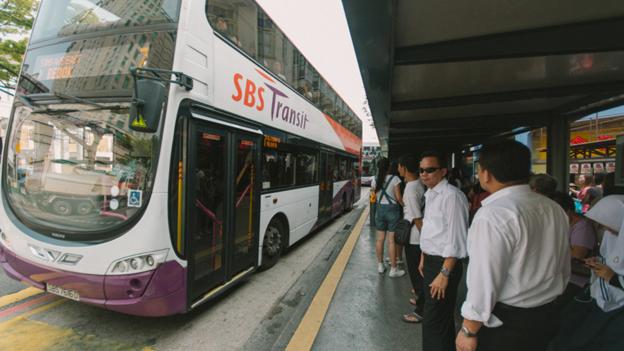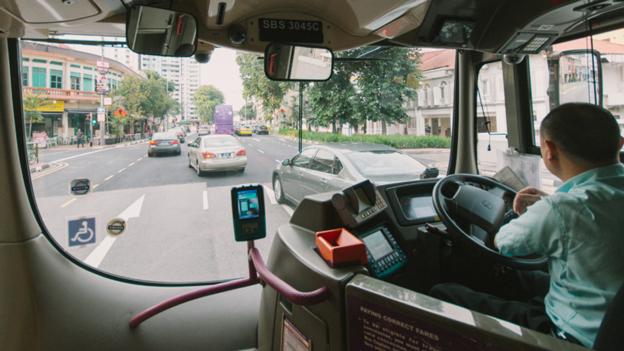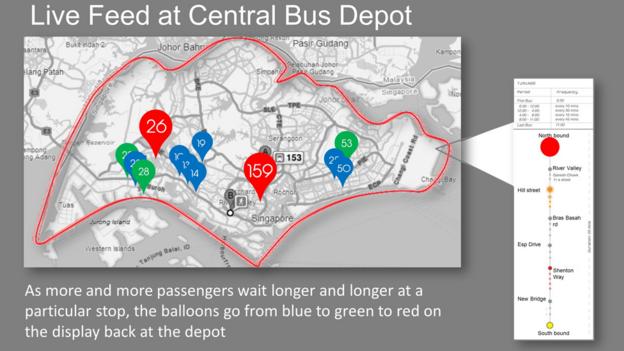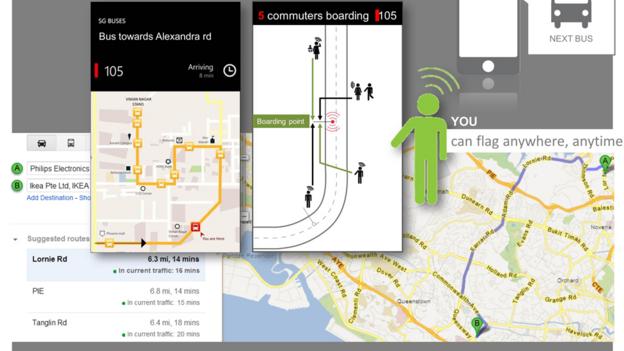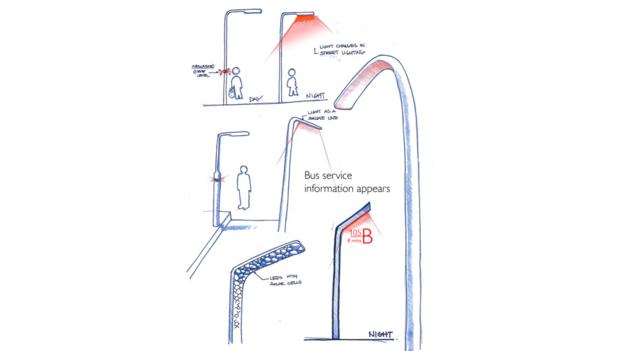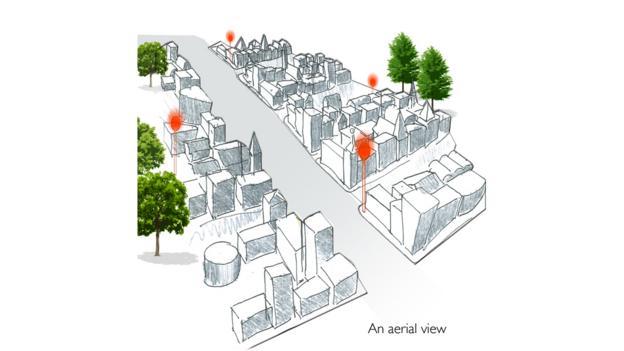- Joined
- Aug 3, 2008
- Messages
- 23,454
- Points
- 0
Radically rethinking the bus system
Despite its daily frustrations, commuting by bus has barely changed for many decades. In the third of BBC Future’s Imagineering redesigns, Philips rethinks the bus stop and the entire service itself – creating a more flexible public transport system for the 21st Century.
Smart mask maps polluted streets
Why great designs always evolve
Commuting by bus has changed little since our grandparents’ days – we wait in line at a bus shelter and board a bus that takes us on a set route to our destination. A digital timetable with an approximate time for the next arrival is about as 21st Century as the average bus stop gets.
For electronics giant Philips, the bus stop is due a radical overhaul. Instead of buses sticking to the same old route every day, why can’t they adapt according to their passengers’ needs, asked the company’s designer Cheaw Hwei Low, who is based in their Singapore design studio. Why can’t bus stops themselves be physically transformed, and move away from the static shelters we are used to seeing on our streets?
So, Low has transported the concept of the bus stop to street light posts and even the smartphone we carry in our pocket. Low’s vision has street lights becoming mini bus stops by integrating bluetooth technology, which connects with transport and smartphone apps – possibly bringing to an end the sight of empty buses ploughing along set, fixed routes.
The Philips redesign has gone far beyond the physical and has completely redesigned the actual process; bus providers would be able to react in real-time to the demands of paying passengers. Using an app, passengers could mark where they want to go from and where they want to end up – with the bus company working out possible routes based on the current demand.
Low talks BBC Future through the concept behind his redesign – one he thinks could radically change the way the population moves around a city.
Why choose the bus stop?
We asked ourselves what is an object that we use and come across every day but do not give much attention, yet it is something we share as a common experience? We hit upon the bus stop, a universal facility seen in all cities, be they mature, developing or underdeveloped. But public transport touches on many aspects of lifestyle, city function, societal behaviour, public-policy making and infrastructure. This makes it complicated, and at the same time interesting to look at beyond its immediate form and function. It became clear we could not look at it merely as a bus stop, but as a total function system, which led us to reframe the problem.
What are the flaws in the original design?
The bus stop is only a part of a total bus transportation system... a fixed-route bus transportation system. So it was logical to look into the system and not just the bus stop. Solving the bus-stop part will not change the system, but we knew we could use it as a trigger point to improving the fixed-route system.
We discussed the benefits and limitations of the fixed-route system – it's clear such a system provided consistency in time and place (to get on and off), and to a certain extent convenience, but not completely. Flexibility is not what a fixed-route and fixed-time bus service system can offer. We have all experienced times when the bus is very empty or extremely packed, which means efficiency is best optimised at the bus-route level, but not individual bus level, since that bus is unable to respond to dynamic demand and traffic situations immediately. We all have all been in situations when there are only a few passengers in the bus and yet, the bus still has to plough through the entire fixed route, picking up no passengers along the way. The motivation was how to optimise the bus service by allowing the passengers and bus drivers to respond immediately to dynamic demand and traffic situations, not unlike a taxi that you can flag anywhere, anytime, and it will take you directly to your destination.
How did you address these flaws?
We went on various bus rides, and along the way we talked to passengers, drivers, bus-terminal-system operators and as many people we could meet across the entire system.
Their inputs were all captured in verbatim, scribbles, sketches, images and video that we mapped into a huge overview in the sequential flow of a bus ride, end-to-end. It produced a very rich picture of the total activity; we felt like we were following the bus route in a helicopter at 30,000 feet, and yet were able to zoom in whenever we want. At the same time, we reached out to our global network to look into bus-service systems all over the world, to ensure we were not reinventing a problem, and learn from other similar situations that would enrich our potential solution. The view we created with the experience flow tool provided the basis for us to really dive deep and start creating ideas.
Where did the inspiration come from?
Looking at how we use smart phones today, drawing parallels with GPRS (General Packet Radio Service), it's clear we don’t do much planning in our lives and yet we can be very responsive spontaneously to the world around us. The relationship of time and space has changed, where it requires us to plan less but yet enable us to be efficient and effective in real time.
What other products designs – not necessarily related – influenced your redesign?
Data visualisation formed a part of the influence. Most of us are visual learners – in a world where people are too busy, a concise, straight-to-the-point image and graphics is exactly what we need to get the information we need in as little time as possible… especially when it is about how to get to where we want to go.
What was the most challenging part of the process?
The design part is relatively easy, as we are free from logistical constraints. We anticipate the most challenging part is influencing a bus-service provider and its stakeholders to adopt such an approach. It requires a change in behaviour on the part of the passengers, and definitely the way a bus-service provider organises its operations.
How radically do your changes alter the design?
By dropping the bus stops out of the equation, we have completely turned the fixed-route approach upside down. Our concept disrupts the robotic regularity of a fixed-route service, perhaps creating new social situations and hopefully reducing carbon footprints in the urban-scape.
How easy will this be to produce?
This will require quite some infrastructure change, and more importantly a mind-set change.
What new technologies, if any, would it require?
The IT architecture behind this system will have to be extremely robust, plus an app system which responds real-time and is able to handle the high volume of real-time feeds.
Will you be taking your design on from here?
This is at concept level, it needs to be taken to a next level of detail to map out total architecture that will support it, but that will require the involvement of all stakeholders.
We are excited by what we have proposed and may reach out to bus-service providers, city planners and policy-making institutions to generate interest.
What has this process taught you?
As with every design activity, to keep an open mind and be ready to change course if it makes sense. We started with the bus stop but ended up with redesigning the bus-service system, which was totally unexpected, but it was because we allowed ourselves to reframe the problem
Despite its daily frustrations, commuting by bus has barely changed for many decades. In the third of BBC Future’s Imagineering redesigns, Philips rethinks the bus stop and the entire service itself – creating a more flexible public transport system for the 21st Century.
Smart mask maps polluted streets
Why great designs always evolve
Commuting by bus has changed little since our grandparents’ days – we wait in line at a bus shelter and board a bus that takes us on a set route to our destination. A digital timetable with an approximate time for the next arrival is about as 21st Century as the average bus stop gets.
For electronics giant Philips, the bus stop is due a radical overhaul. Instead of buses sticking to the same old route every day, why can’t they adapt according to their passengers’ needs, asked the company’s designer Cheaw Hwei Low, who is based in their Singapore design studio. Why can’t bus stops themselves be physically transformed, and move away from the static shelters we are used to seeing on our streets?
So, Low has transported the concept of the bus stop to street light posts and even the smartphone we carry in our pocket. Low’s vision has street lights becoming mini bus stops by integrating bluetooth technology, which connects with transport and smartphone apps – possibly bringing to an end the sight of empty buses ploughing along set, fixed routes.
The Philips redesign has gone far beyond the physical and has completely redesigned the actual process; bus providers would be able to react in real-time to the demands of paying passengers. Using an app, passengers could mark where they want to go from and where they want to end up – with the bus company working out possible routes based on the current demand.
Low talks BBC Future through the concept behind his redesign – one he thinks could radically change the way the population moves around a city.
Why choose the bus stop?
We asked ourselves what is an object that we use and come across every day but do not give much attention, yet it is something we share as a common experience? We hit upon the bus stop, a universal facility seen in all cities, be they mature, developing or underdeveloped. But public transport touches on many aspects of lifestyle, city function, societal behaviour, public-policy making and infrastructure. This makes it complicated, and at the same time interesting to look at beyond its immediate form and function. It became clear we could not look at it merely as a bus stop, but as a total function system, which led us to reframe the problem.
What are the flaws in the original design?
The bus stop is only a part of a total bus transportation system... a fixed-route bus transportation system. So it was logical to look into the system and not just the bus stop. Solving the bus-stop part will not change the system, but we knew we could use it as a trigger point to improving the fixed-route system.
We discussed the benefits and limitations of the fixed-route system – it's clear such a system provided consistency in time and place (to get on and off), and to a certain extent convenience, but not completely. Flexibility is not what a fixed-route and fixed-time bus service system can offer. We have all experienced times when the bus is very empty or extremely packed, which means efficiency is best optimised at the bus-route level, but not individual bus level, since that bus is unable to respond to dynamic demand and traffic situations immediately. We all have all been in situations when there are only a few passengers in the bus and yet, the bus still has to plough through the entire fixed route, picking up no passengers along the way. The motivation was how to optimise the bus service by allowing the passengers and bus drivers to respond immediately to dynamic demand and traffic situations, not unlike a taxi that you can flag anywhere, anytime, and it will take you directly to your destination.
How did you address these flaws?
We went on various bus rides, and along the way we talked to passengers, drivers, bus-terminal-system operators and as many people we could meet across the entire system.
Their inputs were all captured in verbatim, scribbles, sketches, images and video that we mapped into a huge overview in the sequential flow of a bus ride, end-to-end. It produced a very rich picture of the total activity; we felt like we were following the bus route in a helicopter at 30,000 feet, and yet were able to zoom in whenever we want. At the same time, we reached out to our global network to look into bus-service systems all over the world, to ensure we were not reinventing a problem, and learn from other similar situations that would enrich our potential solution. The view we created with the experience flow tool provided the basis for us to really dive deep and start creating ideas.
Where did the inspiration come from?
Looking at how we use smart phones today, drawing parallels with GPRS (General Packet Radio Service), it's clear we don’t do much planning in our lives and yet we can be very responsive spontaneously to the world around us. The relationship of time and space has changed, where it requires us to plan less but yet enable us to be efficient and effective in real time.
What other products designs – not necessarily related – influenced your redesign?
Data visualisation formed a part of the influence. Most of us are visual learners – in a world where people are too busy, a concise, straight-to-the-point image and graphics is exactly what we need to get the information we need in as little time as possible… especially when it is about how to get to where we want to go.
What was the most challenging part of the process?
The design part is relatively easy, as we are free from logistical constraints. We anticipate the most challenging part is influencing a bus-service provider and its stakeholders to adopt such an approach. It requires a change in behaviour on the part of the passengers, and definitely the way a bus-service provider organises its operations.
How radically do your changes alter the design?
By dropping the bus stops out of the equation, we have completely turned the fixed-route approach upside down. Our concept disrupts the robotic regularity of a fixed-route service, perhaps creating new social situations and hopefully reducing carbon footprints in the urban-scape.
How easy will this be to produce?
This will require quite some infrastructure change, and more importantly a mind-set change.
What new technologies, if any, would it require?
The IT architecture behind this system will have to be extremely robust, plus an app system which responds real-time and is able to handle the high volume of real-time feeds.
Will you be taking your design on from here?
This is at concept level, it needs to be taken to a next level of detail to map out total architecture that will support it, but that will require the involvement of all stakeholders.
We are excited by what we have proposed and may reach out to bus-service providers, city planners and policy-making institutions to generate interest.
What has this process taught you?
As with every design activity, to keep an open mind and be ready to change course if it makes sense. We started with the bus stop but ended up with redesigning the bus-service system, which was totally unexpected, but it was because we allowed ourselves to reframe the problem
Last edited:

